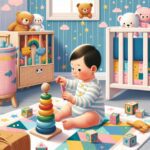Setting up a developmentally stimulating play area at home is an essential step for parents and caregivers who wish to foster an environment that promotes growth, learning, and exploration for their little ones. Creating a space that is both safe and enriched with educational and developmentally appropriate toys can significantly impact a child’s cognitive, physical, and emotional development. This guide will delve into how to create such an environment, ensuring that your baby gets the best start in life.
Understanding the Importance of a Stimulating Play Area
A developmentally stimulating play area at home serves as the foundation for learning and development in the early years of a child’s life. According to research, early experiences in a stimulating environment can have a profound impact on brain development, influencing everything from language acquisition to problem-solving skills.
Moreover, such an environment encourages physical development through activities that promote fine and gross motor skills. It also fosters emotional and social development by providing opportunities for children to explore, experiment, and interact with their surroundings. By understanding the significance of a stimulating play area, parents can make informed decisions about how to best support their child’s growth.
Setting up a Developmentally Stimulating Play Area at Home
Setting up a developmentally stimulating play area at home involves more than just buying toys. It requires thoughtful consideration of the space, the types of activities that will take place, and how those activities will support various aspects of development. Begin by choosing a safe, comfortable area in your home that is free from hazards and conducive to play. Ensure that the flooring is soft and the area is well-lit, creating an inviting environment for your child.
Select toys and materials that are age-appropriate and offer a variety of textures, colors, and shapes to stimulate sensory exploration. Incorporate elements that encourage movement, such as soft mats or tunnels, to support physical development. Additionally, include books and musical instruments to nurture language and cognitive skills. By strategically selecting items for your play area, you can create a comprehensive environment that addresses all facets of development.
Incorporating Educational Elements into the Play Area
Beyond toys, incorporating educational elements into your play area can further enhance its developmental value. This can be achieved through the integration of [learning resources](https://babywhysandhows.com/building-a-reading-routine-for-language-and-emotional-development) that introduce basic concepts such as numbers, letters, colors, and shapes in a playful manner. Interactive storybooks and puzzles can also stimulate cognitive development and problem-solving skills.
Additionally, consider setting up specific zones within the play area that focus on different developmental goals, such as a reading nook for language development or a sensory table for exploration and discovery. Engaging in activities that promote [fine motor skills](https://babywhysandhows.com/activities-to-boost-fine-motor-skills-in-a-9-month-old) and [gross motor skills](https://babywhysandhows.com/understanding-and-promoting-gross-motor-skill-development-in-toddlers) is crucial, so include tasks that encourage grasping, stacking, pushing, and pulling. Tailoring the play area to your child’s developmental needs can significantly impact their learning journey.
Ensuring Safety and Flexibility in the Play Area
Safety is paramount when setting up a developmentally stimulating play area at home. All materials and toys should be non-toxic, free of sharp edges, and appropriate for your child’s age and development stage. Regularly inspect toys for wear and tear, and keep the play area clean and organized to prevent accidents. Additionally, ensure that the space is baby-proofed, with electrical outlets covered and no small objects within reach that could pose a choking hazard.
Flexibility is also key in a developmental play area. Children’s interests and developmental needs change rapidly, so it’s important to adapt the space accordingly. This might mean rotating toys to keep the environment fresh and engaging or altering the layout to accommodate new skills and activities. By staying attuned to your child’s growth and making necessary adjustments, you can provide a play area that continues to stimulate their development over time.
Setting up a developmentally stimulating play area at home is a dynamic process that evolves with your child’s growth. By understanding the importance of such a space, thoughtfully selecting toys and materials, and ensuring safety and flexibility, parents can create an enriching environment that supports their child’s development in meaningful ways. Remember, the goal is to foster a love of learning, encourage exploration, and support your child’s developmental milestones every step of the way.













